What are Earwigs?
Earwigs are small nocturnal insects belonging to the order Dermaptera. They are characterized by their elongated bodies, pincer-like cerci at the end of their abdomen, and membranous wings folded beneath short forewings. Despite their name, earwigs do not typically crawl into human ears.
These insects can vary in size, with adults ranging from 5 to 25 millimeters in length. They have slender bodies and can be brown or black in color. Earwigs are known for their distinctive forceps-like cerci, which they use for defense, capturing prey, and mating rituals.
Earwigs are omnivorous creatures, feeding on a variety of organic matter. They consume plant material such as leaves, flowers, and fruit, as well as other insects, dead animals, and decaying organic matter. Some species of earwigs are beneficial as they help control garden pests like aphids and mites.
Earwigs are primarily active at night and prefer to live in dark and damp environments. They can be found hiding in crevices, under rocks, logs, or in soil. During the day, earwigs seek shelter in cool, moist places to avoid heat and dryness.
While earwigs may occasionally invade homes, they are generally considered harmless to humans and do not pose any significant health risks or cause damage. However, their presence indoors can be an annoyance.
What Kinds of Earwigs are There?
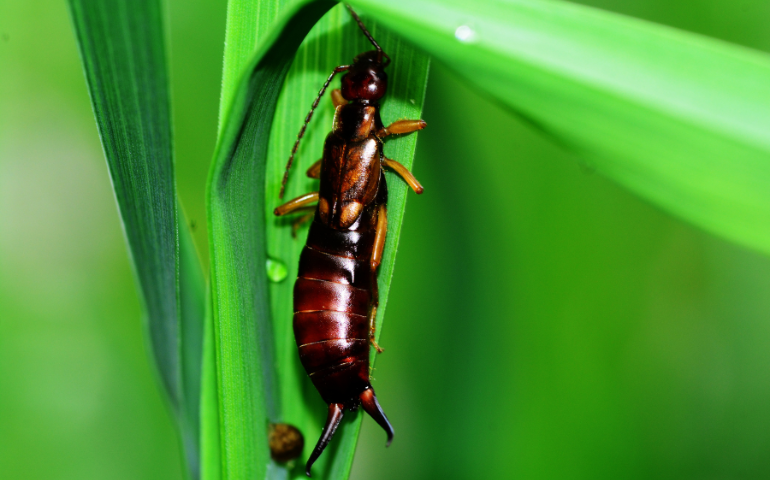
The most widespread earwig in the U.S., the European earwig is recognizable by its reddish-brown body and pincers. They’re attracted to damp areas and can be found in gardens, basements, and bathrooms.
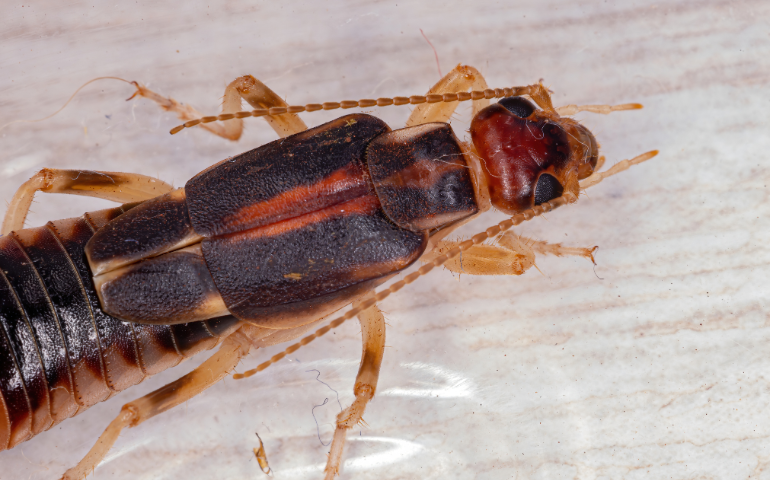
Known for the distinct rings on their legs, these small, dark earwigs often live in soil or under rocks. They are mostly found in the southeastern U.S. and can be spotted outdoors, particularly in moist, sheltered spots.
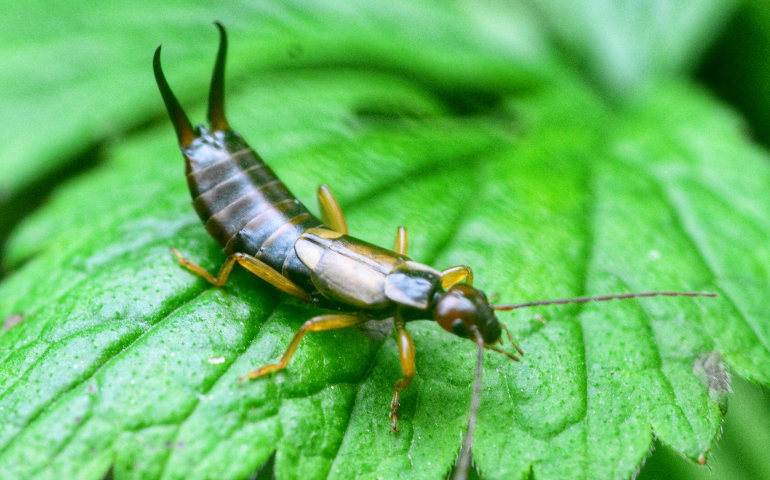
The striped earwig has unique light stripes along its body, setting it apart visually. They’re common in the southern U.S. and prefer warm climates, often making their homes in piles of leaves or compost.
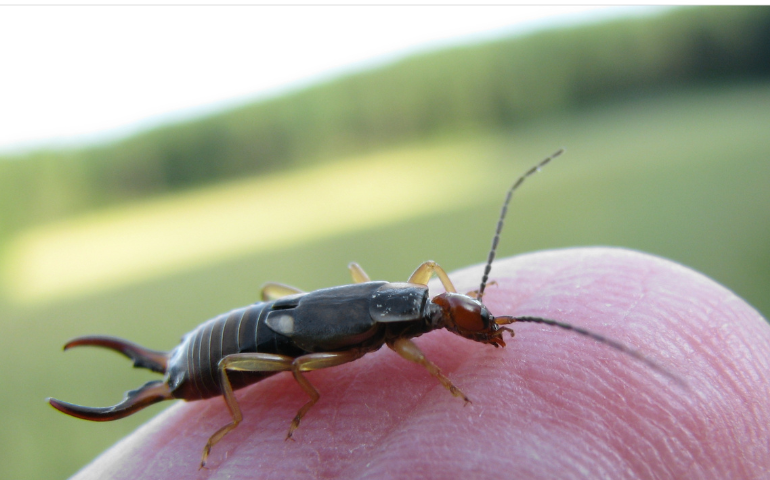
This species lives near coastal areas and is typically found in sandy soil or under rocks by the shore. They have a slimmer, darker body than other earwigs and prefer moist, salty environments.
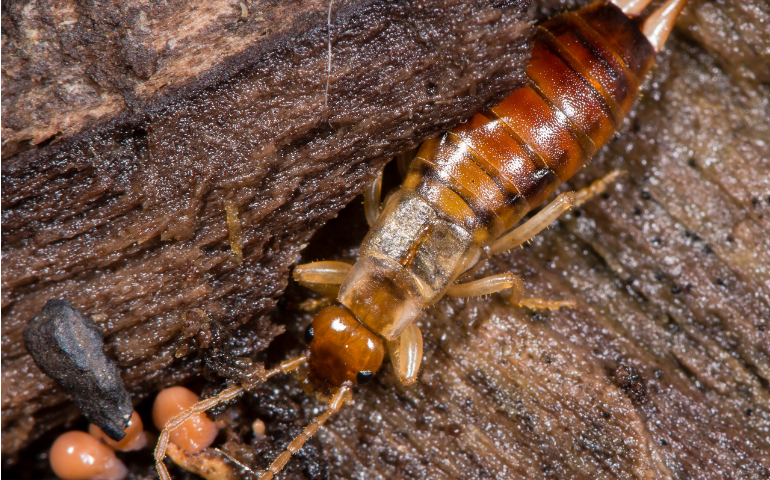
Small and yellowish in color, these earwigs are most common in the western U.S. They’re often found in damp, decaying wood or soil, where they feed on small insects and organic matter.
It’s important to note that earwigs are generally harmless to humans and play a beneficial role in controlling certain insect pests. While they may occasionally enter homes, they are not known to cause significant damage. Earwigs are omnivores, feeding on a variety of organic matter, including plant material and other insects.
Behavior and Habitat of Earwigs
Habitat
Biology and habits of different types of insects are not the same. Earwigs prefer to live in moist, un-managed areas. If conditions are right, earwigs can become a serious problem in your garden. Earwigs can thrive in gardens that have adequate ground cover, food, and moist soil.
Diet
Earwigs eat either decaying or live plants. In rare cases, they can also eat predatory species. Learn more about What earwigs eat.
Fast Moving
Earwigs move very fast. Earwigs are fast-moving and will run quickly when ground litter is removed.
Nocturnal
Night is when earwigs are most active. They hide in damp places and cracks during the day. They can be found under logs, rocks, and mulch in flowerbeds. Earwigs eat plants as well as insects.
Attracted to Lighting
Lights attract earwigs. Earwigs can be a nuisance when they are outside on hot summer nights. They will be collected under cushions or other items that have been left out overnight.
Reproduction
The average number of eggs a female lays is between 30-50, but the exact numbers vary depending on the species. The nymphs go through four to five molts after hatching until they turn into adults. The nymphs, or immature earwigs, look similar to adults but do not have wings. Learn more about the earwigs’ life cycle.
Where to Find Earwigs
Earwigs, though often associated with damp environments, can surprisingly be found in various locations within a household. While they do have a preference for areas with moisture, such as kitchens, bathrooms, and laundries, they are not limited to these spaces. Earwigs are adaptable insects that can also venture into bedrooms, family rooms, and other living areas.
Here’s a closer look at where earwigs can be commonly found within a home:
Kitchens:
In kitchens, earwigs may seek shelter in areas with high humidity, such as under sinks, around leaky pipes, or beneath kitchen appliances. They are attracted to food crumbs and spills, making cabinets, pantry shelves, and countertops potential hiding spots.
Bathrooms:
Similar to kitchens, bathrooms provide ideal conditions for earwigs due to the presence of water. They may inhabit areas near sinks, bathtubs, showers, and toilets, as well as behind baseboards or in cracks and crevices around plumbing fixtures.
Laundries:
Laundry rooms offer another source of moisture, particularly around washing machines, dryers, and utility sinks. Earwigs may congregate in these areas, seeking refuge from the dry conditions elsewhere in the home.
Bedrooms:
While less common, earwigs can also be found in bedrooms, especially if there are sources of moisture present, such as a humidifier or damp bedding. They may hide in closets, under furniture, or behind wall hangings.
Family Rooms:
In family rooms or living areas, earwigs may seek shelter in dark, secluded areas such as behind furniture, in curtains or drapes, or underneath rugs or carpeting.
Despite their ability to inhabit various rooms throughout a house, infestations of earwigs are relatively rare. However, their presence can still be unsettling and may indicate underlying issues with moisture or conducive conditions. If earwigs become a persistent nuisance in your home, it’s advisable to address any moisture problems, seal entry points, and consult with a pest control professional to implement effective control measures.
How to Keep Earwigs From Your Home With Professional Pest Control:
At Alta Pest Control, we understand the importance of maintaining a pest-free home environment. Earwigs, while generally harmless, can become a nuisance when they find their way indoors. Here’s how we address and prevent earwig infestations:
- Thorough Inspection: Identifying entry points and hiding spots.
- Sealing Entry Points: Closing cracks, gaps, and openings to prevent access.
- Customized Treatment: Tailoring plans to eliminate earwigs effectively.
- Environmentally Friendly: Using safe, eco-friendly products.
- Preventive Measures: Implementing strategies to discourage future infestations.
- Client Education: Providing insights on home practices for long-term success.
Trust Alta Pest Control for a home free from earwig nuisances. Contact us today!
